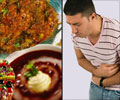A new study, which examined food poisoning in mice, revealed how harmful bacteria, such as salmonella, takes over the good bacteria in the gut environment

Out this week in PLOS ONE, the study shows that Salmonella Typhimurium might use the sugar fucose either as a sign that it has found a good place to reproduce or use fucose to sustain itself during infection, or both. This was the first time researchers saw fucose as an important player during Salmonella infection.
"We were taken completely by surprise with the fucose results," said Adkins. They also saw other sugars that normally are eaten by resident bacteria going untouched. "By knowing what the bacteria eat, we can try to promote the good bacteria and throw off the battle."
The Mice
Food poisoning caused by Salmonella bacteria hits more than 40,000 people every year. One of the common types that infect people, Salmonella Typhimurium, doesn't usually get mice sick, so Adkins and colleagues used mice uniquely sensitive to Salmonella infection. After infecting mice with the disease-causing bacteria orally, the researchers could follow the course of the illness by analyzing what came out of the other end of the mice.
"In most studies, researchers clear out the resident bacteria with antibiotics before introducing infectious bacteria," said microbiologist Brooke Deatherage Kaiser. "In this study, we could watch Salmonella knock out the commensal organisms and then watch them come back. Following the interactions through time is not something we've been able to do before."
Advertisement
The Sugars
Advertisement
This stockpile of unusual sugars likely occurred because the good bacteria had, by that point, been overtaken by Salmonella and another bacterial variety, Enterococci. Enteroccoci are normally found in the gut, but can take advantage of opportunities to overgrow their welcome.
Unexpectedly, several lines of evidence suggested that Salmonella might use the sugar fucose as a food source. This study showed that the bacteria produced proteins that specifically help it digest fucose, which was the first time these researchers observed fucose proteins during Salmonella infection.
Although additional research will be needed to flesh out the role of fucose in the infectious cycle of Salmonella Typhimurium, this observation may help to control or prevent gastrointestinal infection in the future by a better understanding of nutrient sources and signals in the gut.
Overall, the study allowed the PNNL researchers to follow the rise and fall of the infecting bacteria, the fall and rise during recovery of the commensal bacteria, and changes to the gut as the mice fended off the infection. Future research will focus on what happens in other areas of the intestine to get a handle on the difference between the type of illness this study represented, acute gastrointestinal disease, and more systemic infection.
Source-Eurekalert












